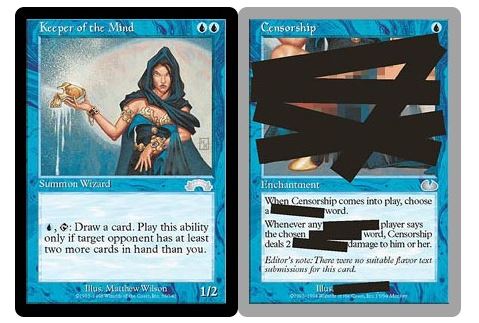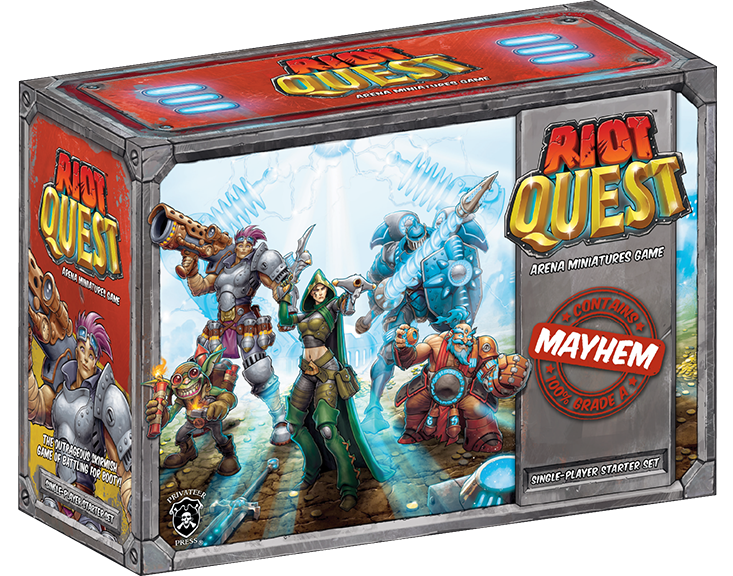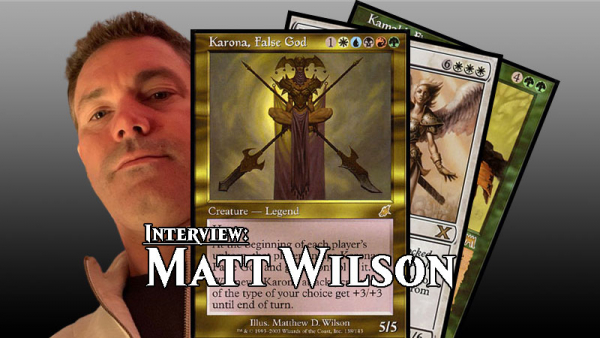Magic: The Gathering artist Matt Wilson joins Magic Untapped for a Q&A.
For years, Matt Wilson was an illustrator and one of the "higher ups" for Magic: the Gathering. This included a 1997-98 stint as the Art Director and being the Lead Concept Artist from 2000 until 2002. Nowadays he's the owner and Chief Creative Officer of Privateer Press, pushing out new games to this day.
We caught up with Matt, who was kind enough to answer some questions about his career and his time working on the Magic collectible card game.
Magic Untapped: What inspirations and influences in your life drove you to becoming a professional artist?
Matt Wilson: I’m sure it sounds like a cliché by now, but like so many other artists, it was Star Wars. I was five years old when I saw Star Wars at a drive-in-movie theater when it first came out, and it blew my mind wide open to the infinite possibilities of creativity. I was already an avid "draw-er" as a kid, and Star Wars gave me a whole new universe to explore in my doodles. A short time later, I saw a television commercial for a book called ‘How to Draw Monsters’ by Larry Evans and that became a formative moment when I realized there was a path to becoming better at drawing the kinds of things that stoked my imagination. The funny thing is, Star Wars also made me want to go to space, and I grew up through most of my childhood wanting to be an astronaut. It wasn’t until I was about 17 and almost done with high school that I realized what I was really passionate about was creating art and stories, and when I finished high school, I turned my sights toward writing and illustrating comic books.
MU: How did you get your start with Magic: The Gathering?
MW: It’s a long story, but here’s the short version: I started a comic book company when I was 20, during the big Image Comics gold rush. I did not strike gold, and a couple years later had a garage full of comic books I had self-published and a sizable debt. Through a game store that I worked at part time (All Star Games in Diamond Bar, CA), I met some folks at AEG and managed to finagle an interview to pitch them a comic series for the magazine they were publishing at the time (Shadis). I noted that they did not have an art director and offered my services if they were interested, though I honestly had no idea what an art director did at that time. They called me the next day and said they weren’t interested in my comic strip, but they did need an art director because they had a collectible card game they wanted to produce called Legend of the Five Rings. I took the job immediately and for the next two years created the Legend of the Five Rings setting, helped develop the game and art directed the first two-years worth of releases.
Then, one day I received a call from Jesper Myrfors who was at that time the art director for Magic. He said they were looking for another art director and he had heard good things about me from many of the artists that we both worked with. I had friends in Seattle and was very interested in moving there so I took the job and soon found myself leading the art direction on Magic: the Gathering.
MU: How long do you typically spend on a piece?
MW: I’ve always been a slow illustrator. The average Magic illustration probably took me anywhere from 20-40 hours of work, depending on the complexity. Daze, however, took me four hours from the time I started the drawing to the time I dried the paint in my kitchen oven so I could rush it to FedEx before the 4:30 p.m. cutoff time. It has haunted me ever since!
MU: You've had the opportunity to illustrate cards for many of Magic: The Gathering's iconic characters, including Rayne, Academy Chancellor, Selenia, Dark Angel, Kamahl, Fist of Krosa, and even Serra herself. Do you approach the art process any differently when tackling such storyline-important figures?
MW: Not really. In a lot of cases, at the time I was creating the illustration, I didn’t even know the characters would later be important. Rayne, for instance, was just another character when I painted her, at least as far as I knew. Other times, I’d actually done the concept for the character so I had some background with them before ever doing the card illustration. But pretty much, the process was the same whether it was a key character or a random monster.
MU: You were art director for Magic: The Gathering from Tempest through Urza's Saga. What was it like being in such a role and, for those who aren't all that familiar with it, what does being an art director entail? How was the process for you?
MW: As an art director for Magic: the Gathering, I took the visual direction provided by the R&D game development team and commissioned artwork to represent their ideas. Basically, they’d provide a few sentences describing a scene or a monster or a spell effect and how the card would work in the game, and then it was my job to interpret that to an illustrator and guide the illustration process so that what we received was something that authentically and accurately represented the concept that the R&D team was going for.
Most of the time, this was a pretty straightforward process. I passed the information to the artists, we’d get a sketch back, the sketch would get approved or adjusted by R&D, I’d send notes back to the artists, they send a painting, and I’d hand that off to the prepress department. (Back when I was art directing, all the artwork was done traditionally and had to be photographed, so there was a lot of physical handling of the work to move it through the process.) Occasionally, things got a little more complicated because R&D had certain requirements for various concepts. Like, when I was art directing, if something had the Flying ability, it had to have wings or at least some visible means of flight. You couldn’t have something that hovered or flew magically without a clear means of flight capability. So, if we got a sketch in that didn’t work with the concept in a way that satisfied the way R&D needed the rules visually interpreted, we’d have to revise.
I only art directed Magic for about a year, and it was a crazy year with hundreds and hundreds of illustrations commissioned. At one point I was working simultaneously with 80 different artists, and back then, most of my art direction was conducted over the phone and sketches were sent via FAX machine. About a year in, I was offered a job as a concept artist for FASA, and at the time, my heart was much more into doing the artwork than it was directing others at it, so I moved on for a bit. And then a couple years later I would return to Wizards in the role of Lead Concept Artist for Magic, which was a really amazing three years where I got to create a lot of the iconic characters and creatures for Magic while leveling up my illustration skills.

MU: There's a story that you submitted artwork for the Exodus card Keeper of the Mind, only to have it cropped by Wizards of the Coast before printing. Then, in the set Unglued, WotC seemed to parody it on the card Censorship. What was that all about, if anything at all?
MW: That was during my stint as art director of Magic. Back then, I was allowed to assign myself illustrations that I could work on outside of my normal office hours. So, I’d work all day in the office doing the art direction and then I’d go home at night and usually put in another eight hours painting. So, despite the sketch getting approved by the various stakeholders who had to sign off on sketches and illustrations, when I turned in the final illustration for Keeper of the Mind, some of those stake holders felt it was too "sexy" to be a Magic card….something to do with the pose the character was in. The solution was easy — we just cropped in on the character and the image was deemed appropriate for publication. Later, when the Unglued set was being art directed by Jesper Myrfors, they pulled the image out in whole and then put black tape all over it for the Censorship card. I don’t know who actually came up with that idea. I’m not even sure if I saw the card before it was printed. But it was a hilarious bit of inside baseball that somehow has become widely known over the past twenty years or so.
For the record, cropping the original image was never an issue for me. That was a brand decision and I was happy to go along with it. But when I sold prints of the Keeper for many years later, I always produced it as the complete, original image.
MU: Have you ever tried a more "out of the box" approach to a card where you try a new perspective or style?
MW: I’ve tried a lot of different styles and techniques. As I mentioned, I’ve always been a slow illustrator, so I explored a lot of different ways to produce the paintings faster. Most of the shortcuts weren’t particularly successful and I returned to what I knew.
During my three years working as Lead Concept Artist for Magic, I also was able to take on some illustration work and at that time was enamored with the idea of painting very large. A lot of the work I did at that time was painted in a vertical format and then cropped in the horizontal dimensions of the Magic card window. Karona, False God, Dragon Mage, Soul Collector, and Fallen Angel, to name a few, only show about half of the final illustration on the card.
MU: Do you have a favorite art medium? If so, does it make fantasy artwork harder or easier to create?
MW: Most of my work was done in oil paint. Oil takes a while to dry, which certainly didn’t help my speed as an illustrator. At one point, I started baking the paintings in the kitchen oven to accelerate the drying time. Don’t try that at home! It stinks up the house and I’m sure is not healthy to breath, but back then it was anything to get the job done on time!
MU: What kinds of things are more tricky for you to create (landscapes, people creatures, etc.)?
MW: I’ve always been a character and creature guy. Landscapes and architecture and not my best subjects. I’ve done a bit of everything, but I think my most successful illustrations have been the characters and creatures.
MU: In 2000, you founded a new gaming company called Privateer Press. What led you to that decision and how have things been going with it over the past two-plus decades?
MW: Another long story but I’ll try to summarize it as concisely as possible! While I was working as a concept artist at Wizards, the 3rd Edition of Dungeons & Dragons was published, and along with it, the D20 Open Game License became available. I knew other people that were self-publishing D20 content under the OGL and got together with a couple friends and decided to create some D&D compatible adventures, just for fun. It was a great way to do some artwork that I wanted to do without having to satisfy anyone other than myself, and I also very much enjoyed the world building process and had a great time conceiving a new setting that we’d place these adventures in. So, Privateer Press was founded as a sort of passion project and we produced a series of adventures called The Witchfire Trilogy, set in a new world called The Iron Kingdoms. Quite unexpectedly, they sold extremely well and we reprinted them multiple times. Their success encouraged us to pursue building a company around our Iron Kingdoms RPG setting, though at the time I never expected it would end up being a life-long endeavor.
After three years working as Lead Concept Artist on Magic, Wizards of the Coast was downsizing and the illustration department was cut. It’s hard to imagine now that would have ever happened considering what a world-wide phenomenon Magic is now. But it was a different time as Wizards was adjusting to being purchased by Hasbro and the two different entities were figuring out how best to work together. Wizards was incredibly generous and gave several months of notice and severance and I was able to use that time to plan out a future with Privateer. At the time, I had started a new project — a miniatures game called Warmachine. It launched in March of 2003, I think about nine months after I had finished at Wizards of the Coast, and I’ve been working at Privateer Press ever since.
MU: And, finally, we understand that Privateer Press is about to launch a Kickstarter campaign. Can you share a bit about that?
 MW: We’ve done quite a few Kickstarter campaigns over the last few years. Our next one is for the Riot Quest board game. Riot Quest has existed as a hybrid miniatures game for several years, but it very much has its roots in the board game genre. It’s a hilarious and chaotic arena game where you assemble a crew of heroes that compete with other crews to loot the ruins of a post-apocalyptic fantasy world (the Iron Kingdoms). The heroes (and villains) are all over-the-top, crazy characters and in this new board game version, the box will be packed with enough gorgeous minis for four players. If all goes well, by the time we get through all the stretch goals, we’ll have to double the size of the box!
MW: We’ve done quite a few Kickstarter campaigns over the last few years. Our next one is for the Riot Quest board game. Riot Quest has existed as a hybrid miniatures game for several years, but it very much has its roots in the board game genre. It’s a hilarious and chaotic arena game where you assemble a crew of heroes that compete with other crews to loot the ruins of a post-apocalyptic fantasy world (the Iron Kingdoms). The heroes (and villains) are all over-the-top, crazy characters and in this new board game version, the box will be packed with enough gorgeous minis for four players. If all goes well, by the time we get through all the stretch goals, we’ll have to double the size of the box!
You can check out Riot Quest here. And if it looks like fun, sign up for our mailing list to get notified when the Kickstarter is about to launch!
Thank you to Matt for participating in this interview.









